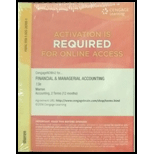
Concept explainers
(a)
Periodic Inventory System:
Periodic inventory system is a system, in which the inventory is updated in the accounting records on a periodic basis such as at the end of each month, quarter or year. In other words, it is an accounting method which is used to determine the amount of inventory at the end of each accounting period.
First-in-First-Out:
In First-in-First-Out method, the costs of the initially purchased items are considered as cost of goods sold, for the items which are sold first. The value of the ending inventory consists of the recent purchased items.
Last-in-Last-Out:
In Last-in-First-Out method, the costs of last purchased items are considered as the cost of goods sold, for the items which are sold first. The value of the closing stock consists of the initial purchased items.
Weighted-average cost method:
Under Weighted average cost method, the company calculates a new average cost after every purchase is made. It is determined by dividing the cost of goods available for sale by the units on hand.
To determine: value of inventory using first in first out method under periodic inventory system.
(b)
value of inventory using last in first out method under periodic inventory system.
(c)
value of inventory using weighted average method under periodic inventory system.
Want to see the full answer?
Check out a sample textbook solution
Chapter 6 Solutions
CengageNOWv2, 2 terms Printed Access Card for Warren?s Financial & Managerial Accounting, 13th, 13th Edition
- Accurate answerarrow_forwardPlease explain this financial accounting problem with accurate financial standards.arrow_forwardAt the beginning of the recent period there were 1,020 units of product in a department, one-third completed. These units were finished and an additional 5,500 units were started and completed during the period. 840 units were still in process at the end of the period. One-fourth completed. Using the weighted-average valuation method the equivalent units produced by the department were: A. 6,730 units B. 6,680 units C. 7,360 units D. 6,390 Units E. 8,250 unitsarrow_forward
- What is the value of inventory listed on the firm's balance sheet?arrow_forwardI am looking for help with this general accounting question using proper accounting standards.arrow_forwardI need help finding the accurate solution to this financial accounting problem with valid procedures.arrow_forward
- How much gross profit was realised from this sale ?arrow_forwardMCQarrow_forwardA manufacturing company applies overhead based on direct labor hours. At the beginning of the year, it was estimated that overhead costs would be $460,000 and direct labor hours would be 91,000. Actual overhead costs incurred were $458,000 and actual direct labor hours were 96,000. What is the amount of overapplied or underapplied overhead at the end of the year? A. $16,000 overapplied B. $16,000 underapplied C. $26,800 overapplied D. $9,000 underappliedarrow_forward
 Financial AccountingAccountingISBN:9781305088436Author:Carl Warren, Jim Reeve, Jonathan DuchacPublisher:Cengage Learning
Financial AccountingAccountingISBN:9781305088436Author:Carl Warren, Jim Reeve, Jonathan DuchacPublisher:Cengage Learning Financial AccountingAccountingISBN:9781337272124Author:Carl Warren, James M. Reeve, Jonathan DuchacPublisher:Cengage Learning
Financial AccountingAccountingISBN:9781337272124Author:Carl Warren, James M. Reeve, Jonathan DuchacPublisher:Cengage Learning Financial And Managerial AccountingAccountingISBN:9781337902663Author:WARREN, Carl S.Publisher:Cengage Learning,
Financial And Managerial AccountingAccountingISBN:9781337902663Author:WARREN, Carl S.Publisher:Cengage Learning, College Accounting, Chapters 1-27AccountingISBN:9781337794756Author:HEINTZ, James A.Publisher:Cengage Learning,
College Accounting, Chapters 1-27AccountingISBN:9781337794756Author:HEINTZ, James A.Publisher:Cengage Learning, Survey of Accounting (Accounting I)AccountingISBN:9781305961883Author:Carl WarrenPublisher:Cengage Learning
Survey of Accounting (Accounting I)AccountingISBN:9781305961883Author:Carl WarrenPublisher:Cengage Learning Intermediate Accounting: Reporting And AnalysisAccountingISBN:9781337788281Author:James M. Wahlen, Jefferson P. Jones, Donald PagachPublisher:Cengage Learning
Intermediate Accounting: Reporting And AnalysisAccountingISBN:9781337788281Author:James M. Wahlen, Jefferson P. Jones, Donald PagachPublisher:Cengage Learning





